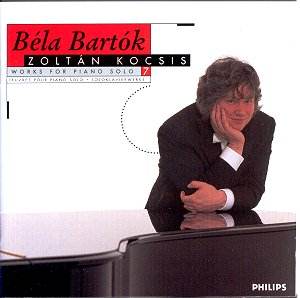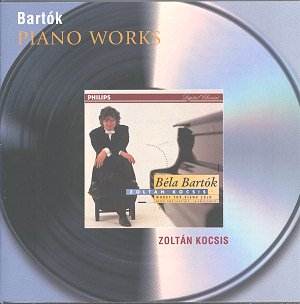 |
Béla BARTÓK (1881-1945) Crotchet AmazonUK AmazonUS Amazon recommendations |
Zoltán Kocsis is a pianist who has a strong affinity with the music of his compatriot Béla Bartók. After all, this disc is the seventh and final item in an impressive series devoted to the master's complete music for piano solo. That, however, is both its strength and its weakness as an individual recital.Little of the music featured here ranks among Bartók's greatest achievements for the keyboard. Only one of the pieces is a real masterpiece, the Dance Suite written for orchestra in the mid-1920s in celebration of the 50th anniversary of the union of Buda and Pest. But the piano version is a transcription from the 1940s, not an original work, and stirring though it undoubtedly is in this performance by Kocsis, anyone who knows the original work will yearn for its greater variety and in particular for its colourful orchestration. The music plays across a large scale of some fifteen minutes, and affords the pianist opportunities galore, opportunities which Kocsis takes with much brilliance and dexterity. Even so, it is not the real thing.
This process is reversed in the case of the Rhapsody, Opus 1, which was originally a piano solo, before Bartók added an orchestral accompaniment to turn it into a quasi-concerto. This version is certainly compelling, justifying its nineteen-minute span and allowing Kocsis to display his technique in a wide range of challenges, including subtle rubatos and powerful sonorities. Here as elsewhere the Philips recording supports him admirably, at once atmospheric and allowing for a detailed focus.
However, the Rhapsody is an early work written when Bartók was just 23, and the music owes a good deal to Liszt, though of course there is nothing wrong with that. There is also a later, revised version included here, which loses nearly ten minutes of music while adding a new coda. Listening carefully to both versions, it is very tempting to suggest that what we have here is not a performance, and that only this coda has been recorded separately, with the large cut and the coda effected by the engineers in the studio. This is difficult to prove, but either way it does serve to confirm the extent of this disc being the last in a series, attempting to 'fill the gaps'.
The funeral march taken from the symphonic poem Kossuth is another early work. In this music the influence is that of Richard Strauss, but the music is none the worse for that in its powerful dramatic intensity. Then there are the Four Pieces: respectively entitled 'Study for the left hand', Fantasy I and II, and Scherzo. The Lisztian quality is heard in these early pieces too, though the Scherzo has more exotic harmonies. Again the performances are exemplary, but in truth this is a disc for the specialist, or for the collector who likes things to be absolutely complete.
Terry Barfoot
Béla BARTÓK (1881-1945)
Solo Piano Music
Sonata
Out of Doors
Two Rumanian Dances
Three Hungarian folk dances from Csik
Rumanian Christmas Carols;
Fourteen Bagatelles
Sonatina
Zoltan Kocsis
PHILIPS 464 676-2 [78.37]
Crotchet AmazonUK AmazonUS Amazon recommendations
These recordings were made in 1992, 1994 and 1997 and now appear in this compilation.
What a really great composer Bartok was, and is!
The splendid Piano Sonata of 1926 has an opening movement that seems to inhabit a Lydian mode and centres in E major. Horowitz made an outstanding recording of this masterpiece albeit in his own style. Kocsis is good but the work needs more aggression. Incidentally, shame on the reviewer who called the piano a string instrument. It is a percussion instrument and Bartok knew this! The slow movement has a folk song feel about it and I wish Kocsis had built it up more convincingly. I have just listened to Gyorgy Sandor's performance which has the quality I expect in this rather special music. Kocsis does well in the finale but there is still a lack of attack and the dramatic tension does not reach the heights inherent in the score. His fingerwork is quite dazzling, though.
Out of Doors is a five movement suite which is important to show Bartok's development as a composer. It is a form that he used in his later string quartets and no one who knows music can deny that his string quartets are the best ever written. Kocsis is better in this suite although I would prefer the music's violence to be more apparent. After all, the first movement is called With Pipes and Drums. The second movement is a busy Barcarolle and the third imitates the bagpipes in a piece called Musettes. The Night Piece is another example of how well Bartok developed this form as invented by John Field and was taken up by Chopin. But Bartok's nocturnes are not pretty pastel-shaded miniatures but very expressive and satisfying essays.The Two Rumanian Dances of 1910 are original and yet show his fascination with the culture of his homeland and neighbouring countries. That he kept alive the peasant music in a more permanent form and in other works as well is commendable and of great historical interest.
The rest of the items on the disc are slight but rewarding. They unintentionally show us how modest Bartok was as a person. He was not out to be a star and have people worship at his feet like some composers of the twentieth century. Those arrogant composers have no place in music as far as I am concerned. The greatest men are the humblest of men and such men allow their art to speak for itself. Self-aggrandisement is no recommendation.
These are not the best Bartok performances and I do not share the enthusiasm of the reviewer in The Gramophone which is quoted on the back of the disc. I do not think Kocsis has the right style or approach. Nor do I like the contemporary approach to 'clean up' Bartok and refine his music by which the aggression, vitality and his magnificent individual style is lost. The current campaign or fashion to turn Bartok into a classical composer is most misguided. He was a modern composer and, quite frankly, one of that very rare breed that can honestly be called the very best.
He was a thinking man's composer!
David Wright
